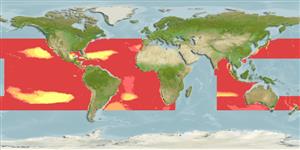Teleostei (teleosts) >
Lophiiformes (Anglerfishes) >
Oneirodidae (Dreamers)
Etymology: Chaenophryne: Greek, 'chaeno' or 'chaino' = to gape + Greek, 'phryne' = toad (alluring to a "gaping toad") (Ref. 86949).
More on author: Beebe.
Environment: milieu / climate zone / depth range / distribution range
Ecology
Marine; bathypelagic; depth range 350 - 1750 m (Ref. 58302). Deep-water; 44°N - 42°S, 180°W - 180°E
Tropical and subtropical parts of all oceans. Eastern Atlantic: A single female was recorded north of Madeira. Eastern Pacific: Oregon, USA and British Columbia, Canada (Ref. 6885). Western Pacific: Japan (Ref. 559) and Australia (Ref. 7300).
Size / Weight / Age
Maturity: Lm ? range ? - ? cm
Max length : 12.3 cm SL male/unsexed; (Ref. 75756); common length : 8.3 cm SL male/unsexed; (Ref. 6885)
Short description
Identification keys | Morphology | Morphometrics
Dorsal spines (total): 0; Dorsal soft rays (total): 6 - 8; Anal spines: 0; Anal soft rays: 5 - 6. Caudal large; pectorals small, pediculate, directed upward (Ref. 6885). Black except for pale on esca at end of illicium (Ref. 6885). Distinguishing characteristics: esca with single conical to elongate, internally pigmented anterior appendage, less than one-seventh to nearly one-third length of escal bulb; absence of medial escal appendages; posterior escal appendages with swollen basal portion and compressed distal crest, posterior filament or filaments and pair of anterior lobes each with numerous filaments; anterolateral escal appendages and basal series of filaments absent; have the highest ratio between the number of upper and lower jaw teeth of any species, 1.08-1.45; total number of teeth in upper jaw 35-47, lower jaw with 31-38 teeth; vomerine teeth 4-8; slightly shorter illicium compared to C.ramifera and slightly longer than that of C.melanorhabdus, length 24-36.4% SL (Ref. 86949).
Body shape (shape guide): short and / or deep.
Meso- (Ref. 10524) and bathypelagic (Ref. 58302). Males dwarfed, non-parasitic (Ref. 10524). Specimen examined was 9.7 cm SL from Auckland Institute and Museum (AIM 6609) (Ref. 58502).
Life cycle and mating behavior
Maturity | Reproduction | Spawning | Eggs | Fecundity | Larvae
Bertelsen, E., 1990. Oneirodidae. p. 498-507. In J.C. Quero, J.C. Hureau, C. Karrer, A. Post, and L. Saldanha (eds.) Check-list of the fishes of the eastern tropical Atlantic (CLOFETA). JNICT, Lisbon; SEI, Paris; and UNESCO, Paris. Vol. 1. (Ref. 10524)
IUCN Red List Status (Ref. 130435: Version 2025-1)
Threat to humans
Harmless
Human uses
Tools
Special reports
Download XML
Internet sources
Estimates based on models
Preferred temperature (Ref.
123201): 4.1 - 7.9, mean 6.1 °C (based on 492 cells).
Phylogenetic diversity index (Ref.
82804): PD
50 = 0.5312 [Uniqueness, from 0.5 = low to 2.0 = high].
Bayesian length-weight: a=0.01995 (0.00906 - 0.04395), b=3.01 (2.83 - 3.19), in cm total length, based on all LWR estimates for this body shape (Ref.
93245).
Trophic level (Ref.
69278): 3.8 ±0.5 se; based on size and trophs of closest relatives
Resilience (Ref.
120179): Medium, minimum population doubling time 1.4 - 4.4 years (Preliminary K or Fecundity.).
Fishing Vulnerability (Ref.
59153): Low vulnerability (10 of 100).
🛈
Nutrients (Ref.
124155): Calcium = 53.2 [17.1, 134.8] mg/100g; Iron = 0.442 [0.179, 1.356] mg/100g; Protein = 18.3 [15.5, 21.5] %; Omega3 = 0.207 [0.058, 0.720] g/100g; Selenium = 12.4 [3.5, 38.1] μg/100g; VitaminA = 57.2 [6.2, 532.1] μg/100g; Zinc = 0.531 [0.255, 1.102] mg/100g (wet weight);
